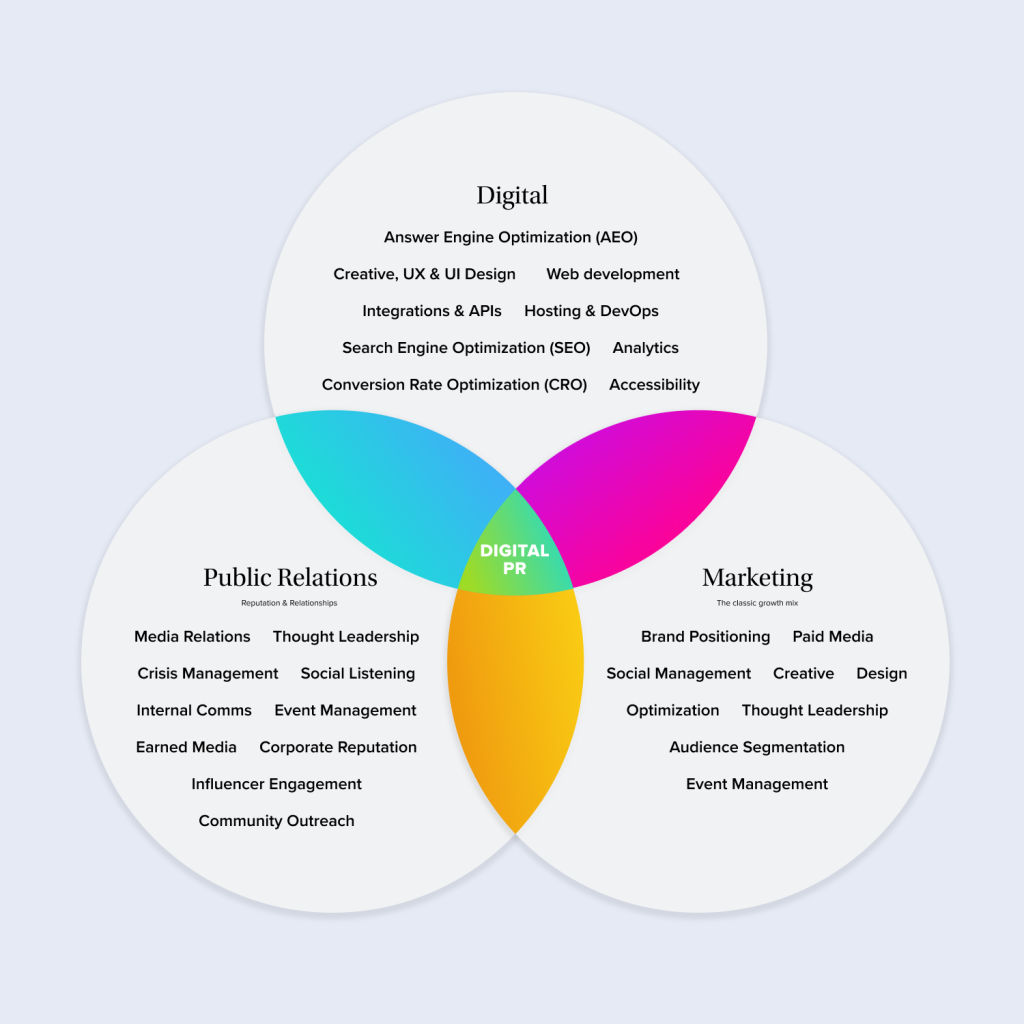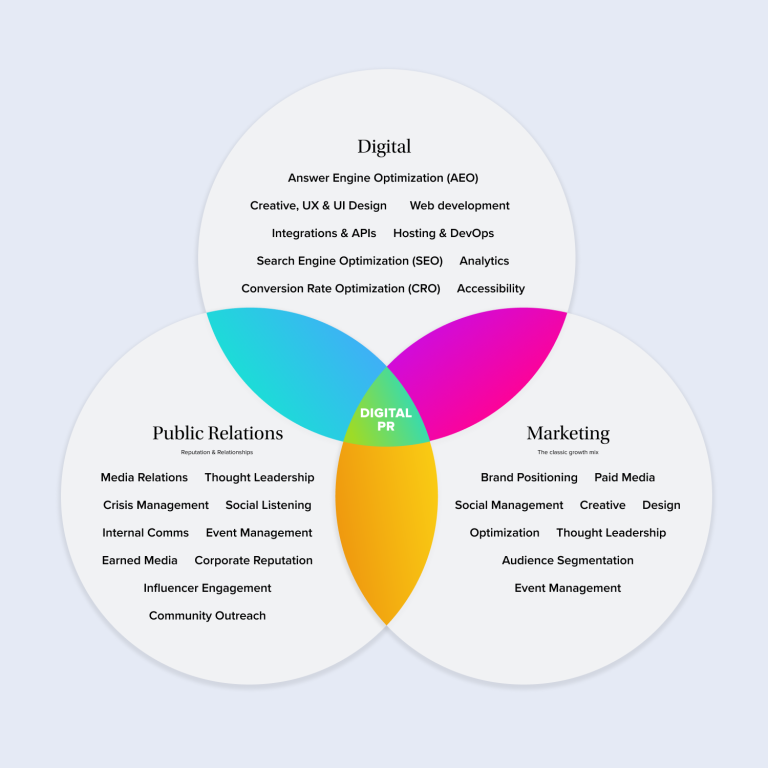
Large language models (LLMs) like OpenAI’s ChatGPT and Google’s Gemini are redefining search. The first impression of your brand might not come from your PR, content marketing, website, or press at all. Your brand voice is increasingly delivered by an AI-powered “answer engine” that aggregates facts, snippets, and even hearsay about your organization into a single response. Instead of showing a list of search results, these “agentic” and “search AI” systems – embedded commonly in search platforms and voice assistants – synthesize information from across the web into one authoritative answer not written by you.
For enterprise brands, national associations, and global nonprofits alike, this represents a seismic shift in how public relations and marketing must operate. Traditional branding and PR tactics, while still necessary, are no longer sufficient on their own. To protect and enhance digital visibility in this AI-first search environment, organizations must embrace a new discipline: Answer Engine Optimization (AEO).
AI-Curated First Impressions
Imagine a prospective donor asking an AI assistant about your nonprofit’s impact, or a potential client querying ChatGPT about the best supplier in your industry. The AI’s answer will likely be the user’s first interaction with your brand, and it will be drawn from whatever data the model can find – your website text, press releases, product feeds, customer reviews, social media chatter, Wikipedia entries, news articles, and even employees’ public LinkedIn profiles.
Consumers increasingly expect AI to deliver a definitive, personalized answer without scrolling through pages of links. This is fundamentally transforming search from an exercise in finding information to one of receiving curated responses. Instead of ten blue links, users get a single narrative – one that might mention your brand (positively or negatively) based on the AI’s synthesis of “the web’s best information”.
Such AI-generated narratives can make or break a first impression. They often come across as factual and authoritative – after all, a machine compiled them – so any misinformation may be readily believed by the user. For instance, ChatGPT’s answers have been known to include outdated or incorrect details, like recommending a restaurant that closed years ago and even naming a chef who had passed away.
If an AI can mistakenly keep a defunct restaurant in its recommendations, it could just as easily surface a “phantom office” location your company shut down long ago or a product feature you deprecated – all because that info still lingers in some corner of the web.
Research shows that one in ten U.S. internet users now turns to generative AI first for online search, and ChatGPT alone has 400 million people using it weekly. Google’s own AI integration is advancing quickly: AI-generated overviews now appear in 16% of all Google searches in the U.S. and the percentage is growing fast, very fast. We’re rapidly approaching a point where AI answer engines will dominate search behavior, meaning the stories they tell about your brand will reach audiences before your own content ever can.
The New Gatekeepers of Brand Narrative
LLM-powered answer engines don’t just retrieve facts; they compose narratives. Ask an AI, “What does Organization X do?” and you’ll get a cohesive summary: perhaps a mix of your mission statement, recent news, customer feedback, and tidbits about your team. Crucially, these models are designed to be helpful and avoid misinformation, which means they often prefer information from “trusted” third-party sources over purely self-published content. High-authority outlets – major news sites, reputable databases, academic papers, .gov domains – are weighted heavily in many AI systems to reduce the risk of errors.
For your brand, that means an AI might trust an old press article or a government filing more than your polished new homepage. This has profound implications. Without human context, models don’t inherently know which piece of data is outdated or inaccurate. They must rely on patterns and prominence in their training data or live web crawl. As one AI researcher put it, “when AI models are built on incomplete, inaccurate, inconsistent… data, they deliver incorrect answers.”
Consider a composite scenario that digital agencies are encountering: A national association finds that when people ask an AI assistant about them, it confidently lists regional chapters that never existed or were shut down years ago. How did this happen? It turns out an old brochure on a forgotten webpage still listed those chapters, and a few staff LinkedIn profiles mentioned overseeing those regions. The AI aggregated these scraps into a “fact” – a phantom office – now presented to the world.
In another case, a software brand discovers that a popular AI tool’s comparison of them vs. a competitor is skewed: the AI repeats the competitor’s boast from a biased blog post and omits the enterprise’s key strengths. Why? Because the competitor’s content was clear, structured, and everywhere the AI looked, whereas the brand’s own data on that feature was buried or unstructured. The result: prospective customers get a distorted story, and the brand loses the sale before the prospect ever visits their site. These examples illustrate how LLMs can unintentionally modify your brand narrative – or let others modify it – by amplifying whatever information they find.
Traditional PR and SEO Fall Short
For years, organizations have relied on search engine optimization (SEO) to control what appears on that critical first page of Google results, and on public relations to craft messaging in press releases and media coverage. But in this new landscape, those tactics alone don’t guarantee control over the narrative that AI presents. SEO aimed to influence the ranking of your content in search results, but AI answers don’t always even show a link to your site – they might present an answer without a click. Winning at SEO traditionally meant optimizing keywords, meta tags, and backlinks to rise to the top of search listings.
Answer Engine Optimization (AEO) has a different focus: making sure the AI mentions your brand and uses accurate, up-to-date details when constructing an answer. The “ranking” in an AI answer is essentially whether you’re included and cited as an authority, rather than your link being number one. And as the agentic revolution approaches, AI agents will do research, make selections, and purchase on behalf of people. Skeptical? Read this article or just research it via Google AIO.
It’s not that SEO is dead – far from it. SEO and AEO are complementary; in fact, many fundamentals overlap (good content, structured data, authoritative reputation). But the rules of the game are changing. Buyers are turning to AI assistants for research and vendor selection – we’ve seen this firsthand. Gartner analysts predict that by 2026, traditional search engine use will drop 25% as users shift to AI-powered tools. Google’s Gemini, OpenAI’s ChatGPT, and others are rapidly ushering in this era of AI-driven search.
In practical terms, that means fewer opportunities for your carefully crafted SEO content to be seen directly by users, and more instances of an AI telling users about your content (or about someone else’s content about you). Brands that continue to obsess over just old-school SEO metrics – keywords, H1s, link-building – risk losing visibility to more “AI-aware” competitors. In fact, companies solely focused on traditional search are already watching market share evaporate as competitors gain AI visibility — and become the trusted source that’s difficult to displace.
Traditional public relations faces a similar evolution. Press releases and media pitches used to directly shape the news stories people read about your organization. They still do – but now those stories are being distilled by LLMs into the bullet points that form an AI answer. PR has always been about securing third-party validation (a news article, an expert quote, a case study) to build credibility. That matters even more now, because AI systems heavily favor trusted third-party sources to avoid misinformation.
In effect, your PR wins (articles in respected publications, quotes in industry outlets, mentions by influencers) are not just influencing human readers – they’re training the algorithms on what to say about you. If your brand has been covered extensively by high-authority media and cited alongside certain topics, an AI is more likely to include you when answering a related question. For example, if a health-tech association consistently gets quoted in healthcare journals about new regulations, an AI like ChatGPT might recall that and mention the association when someone asks about healthcare compliance. Without that third-party coverage, the AI might not even know the association exists!
Answer Engine Optimization (AEO): A New Discipline Emerges
Just as SEO arose to help organizations rank in search results, AEO has emerged to help organizations become the answer in AI-generated responses. Answer Engine Optimization is the practice of preparing your content and digital presence so that AI systems will reliably cite, reference, or recommend your brand when providing answers in your domain. Instead of focusing purely on blue links and click-throughs, AEO asks: “When an AI is asked about our industry or product category, will it mention us? Will it get our facts right?” It’s about making your brand discoverable, trusted, and cite-worthy to AI.
AEO builds on many SEO fundamentals – high-quality content, authoritative backlinks, schema markup, fast-loading sites – but also extends into new territory. For example, optimizing for answer engines means crafting content in a way that directly answers common user questions, in concise snippets, because AI loves clear Q&A-style information. It means ensuring crawlers used by AI (like OpenAI’s OAI-SearchBot) can access your site – if your robots.txt accidentally blocks them, you become invisible to ChatGPT’s web browsing mode. It might even mean adopting emerging technical standards like llms.txt files – a nascent concept similar to sitemaps, which provide AI-specific guidance by pointing models to your most accurate, up-to-date content. (Think of it as leaving breadcrumbs for the AI agent to find the truth amidst the noise.)
Crucially, AEO shifts the focus from driving clicks to ensuring inclusion and accuracy in the answer itself. In the search era, you won if the user clicked your link; in the answer engine era, you win if your brand is mentioned correctly even if no click occurs. That requires a mindset change. You’re not just competing for attention – you’re competing to be the source that an AI trusts to quote or paraphrase. Companies proactively tracking and optimizing for LLM visibility are already seeing measurable growth – and even higher conversion rates from AI-driven traffic – compared to those sticking to traditional SEO alone. In other words, the early adopters of AEO are reaping rewards, while laggards risk losing mindshare as AI-driven answers favor their competitors.
The Risks of Ignoring AI’s Narrative Power
Failing to adapt to this new reality can carry steep risks. We’ve touched on a few: outdated facts resurfacing, office locations, or competitor slants creeping in. Let’s unpack the risk landscape:
Outdated or Incorrect Information Amplified
LLMs are trained on vast datasets that may include your historical web content and old third-party references. They don’t inherently know which facts have changed unless new data overtakes the old. That means mistakes can live on in AI answers long after you’ve corrected them elsewhere. An AI might cite a product specification from three years ago if it’s documented in a forum or cached page, leading customers astray about what you currently offer. We saw how ChatGPT recommended a closed restaurant due to stale data – translate that to your business, and it could be touting a service you no longer provide or a founder who’s no longer with the organization. Such inaccuracies can quietly erode trust.
Inconsistent Digital Footprint = Confused AI
Enterprise brands and large nonprofits often have sprawling digital footprints (with many or no owners!) – multiple websites, social media accounts, press releases, directory listings, perhaps even wiki pages. If these sources don’t agree on basics (like your locations, leadership, mission statement, or pricing), an AI may try to reconcile or mention them all, resulting in a confusing or contradictory answer. Inconsistencies that a human might recognize as old vs. new, an AI might blend together unless those old signals are cleaned up. Experts now advise brands to audit all the content they’ve published over the years and eliminate or update anything that sends the wrong message, precisely to prevent such AI confusion.
Misinformation and “Hallucinations”
In worse cases, an AI may fill gaps with its own invention – the infamous AI hallucination. This tends to happen when it can’t find a clear answer, so it synthesizes one to be helpful. If your digital presence is sparse on a topic, the AI might speculate or borrow from loosely related info. For example, if several employees on LinkedIn mention working on a project, an AI asked about your company might erroneously “promote” that project to a core offering, even if it was just an internal initiative. Or it might conflate your organization with another of a similar name if it isn’t sure. While AI models try not to lie, they will produce something to avoid saying “I don’t know.” Robust, consistent data can prevent this by leaving less room for the AI to make false guesses.
Unintended Associations
LLMs associate words and concepts based on patterns in training data. Your brand might be mentioned frequently alongside certain topics or values. If those associations are negative or off-brand, they can bleed into AI descriptions. You might be proud of an initiative, but if an AI always mentions it and your audience reacts poorly to it, that’s a reputational issue to manage. The key point: AI will reflect back the associations it has absorbed – so you need to be mindful of what signals (positive or negative) your digital footprint is sending.
Given these risks, it’s clear that digital agencies and brand stewards must broaden their charter. It’s no longer enough to drive traffic and press mentions; now you must also ensure that the synthesized narrative assembled by AI aligns with reality and your branding. This is where Answer Engine Optimization and proactive digital strategy come to the forefront.
Digital Agencies as Stewards of AI-Era PR and Brand Integrity
Many enterprise brands, associations, and nonprofits turn to digital agencies or in-house digital teams for guidance – and that guidance must now extend to AEO and AI Agent narrative management. Agencies have a new responsibility to act as stewards of brand integrity in an AI-first search environment. What does this entail? It means agencies should be conducting the audits, implementing the right schema, crafting the content, and coordinating the PR/SEO/analytics trifecta. It’s a more interdisciplinary effort than traditional SEO. PR specialists, SEO strategists, content marketers, and even data engineers need to collaborate closely.
For example, an agency might lead a workshop with a client’s PR and SEO teams to map out all the “entities” and facts about the brand that must be consistent everywhere – essentially creating a source-of-truth reference that all content aligns to (sometimes called a messaging house or narrative brief). They might set up alerts or dashboards for AI mentions of the brand.
Agencies can also help interpret the insights that come from AI monitoring. If a brand isn’t being mentioned by AI in topics it should dominate, an agency could diagnose why: maybe a competitor has flooded the content landscape, or maybe the brand’s thought leadership or product content isn’t utilizing the right terminology that the AI recognizes. The digital agency becomes the guardian of the brand’s digital truth across the web – not just on the client’s own properties, but everywhere information lives and thus anywhere the AI might learn about the brand.
This is especially critical for nonprofits and associations that often have limited resources and may rely on volunteers or distributed teams to handle communications. An agency partner can provide the centralized oversight needed to keep the digital narrative aligned. For instance, ensuring a global nonprofit’s various country websites all reflect the same core facts, or helping a professional association reconcile discrepancies between its main site, a membership database, and what external data sources say about its size or activities. The goal is to present a unified, accurate front to the algorithms scanning the information universe. In doing so, agencies also uphold public trust: by minimizing misinformation and inconsistencies, they help AI deliver truthful answers about clients, benefiting everyone (user, client, and AI provider alike).
Five years ago, the idea that you’d optimize for anything other than classic search engines might have sounded niche. Today, it’s clear that AEO is becoming as fundamental to digital strategy as PR, Marketing and SEO once were (and in many ways, is their logical evolution). When 75% of internet users’ queries might soon be handled by AI assistants – a stat given by some industry analysts given current growth trajectories – then optimizing for those assistants isn’t niche; it’s mission-critical. This applies whether you’re a Fortune 500 brand carefully managing global reputation or a national nonprofit rallying public support. If you depend on being found and understood online, you now depend on AI’s ability to find and understand you.
So, what does being mission-critical really mean in practice? It means AEO is not a one-off project or a single dashboard to check. It’s an ongoing discipline and requires this mindset. It’s not a one off project like website redesign or marketing campaign. Every new piece of content you release, every campaign, every data point – consider how an AI might interpret and integrate it. It means budget and resources should be allocated to AEO initiatives, just as they are to PR, Marketing, and Digital ones. It means educating leadership that success might look like an AI mentioning our program as a best practice, not just a page-one Google result. Those intangibles have real business impact, even if they’re harder to measure with legacy KPIs.
Those who proactively optimize for answer engines will shape the narratives about their brands, rather than being shaped by them. AEO is an opportunity to build trust at scale.
For brands, nonprofits, and associations alike, this is a call to action: evolve now, and take the helm of your brand narrative in the era of answer engines. Those that do will build digital visibility and trust that’s ready for the future – a future where being the answer is everything. Answer Engine Optimization (AEO) is a game changer and you probably could use a helping hand. Let’s chat.



